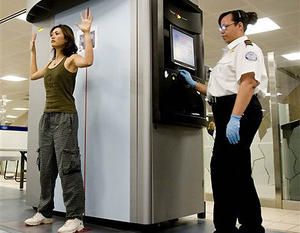Aviation securityEU to allow full-body scanners at airports
In response to the continued threat of terrorism, the European Union (EU) recently passed legislation that would formally European airports to use full-body scanners; prior to Monday’s announcement, trial usage of full-scanners was limited to a period of thirty months; under the new rules, member states will have the option for unlimited deployment of the scanners, but will not be required to use them

EU now willing to accept full-body scanners // Source: familyhomesecurity.com
In response to the continued threat of terrorism, the European Union (EU) recently passed legislation that would formally European airports to use full-body scanners.
“As a common EU-wide framework, the new legislation legally allows Member States and airports to replace current security systems with security scanners. It also ensures the uniform application of security rules at all airports and provides strict and mandatory safeguards to ensure compliance with fundamental rights and the protection of health,” the EU Transportation Commission said in a statement.
The scanners have been deployed on a trial basis in some European airports since the 25 December 2009 attempt by Umar Farouk Abdulmutallab to detonate plastic explosives aboard a Detroit-bound flight from Amsterdam. Countries participating in the trials included the Netherlands, the United Kingdom, France, Finland, Germany, and Italy.
Prior to Monday’s announcement, trial usage of full-scanners was limited to a period of thirty months. Under the new rules, member states will have the option for unlimited deployment of the scanners, but will not be required to use them.
In order to address privacy concerns, the EU will require states wishing to use the scanners to do so under “strict operational and technical conditions.”
These measures include the requirements that scanners do not store, retain, copy, print, or retrieve images, and that the security analyst reviewing the images be in a separate location so as not to link the images to the passenger being screened.
The U.S. Transportation Security Administration is currently upgrading the software of its full-body scanners so that detailed images of scanned passengers are replaced with the generic outline of a human body.
Passengers will also be informed beforehand about the nature of the scans and are given the option of an alternative form of screening, as is currently the case in U.S. airports.
The new rules have been criticized by some privacy organizations. “These scanners may produce strikingly clear images of passengers’ bodies, amounting to a significant - and for many people, humiliating – assault on dignity that citizens of free nations should not have to tolerate,”saidGus Hosein, executive director of London-based Privacy International.
EU vice-president Siim Kallas, who is in charge of the Transport Commission, believes that the change will significantly improve aviation security in Europe while adhering to the EU’s commitment to individual rights.
“Security scanners are not a panacea but they do offer a real possibility to reinforce passenger security,” he said. “Security scanners are a valuable alternative to existing screening methods and are very efficient in detecting both metallic and non-metallic objects. It is still for each Member State or airport to decide whether or not to deploy security scanners, but these new rules ensure that where this new technology is used it will be covered by EU wide standards on detection capability as well as strict safeguards to protect health and fundamental rights.”
